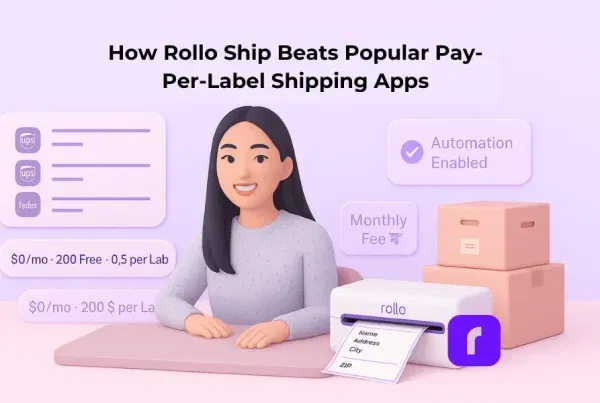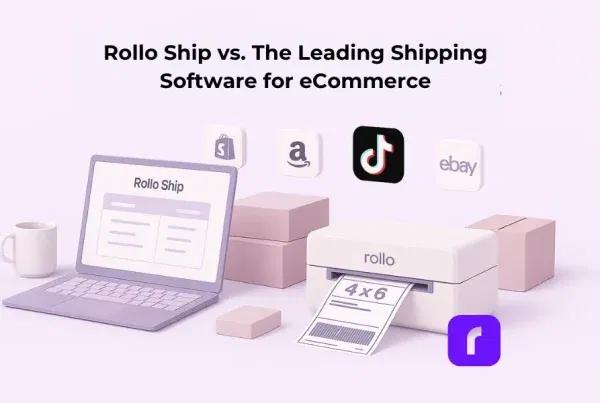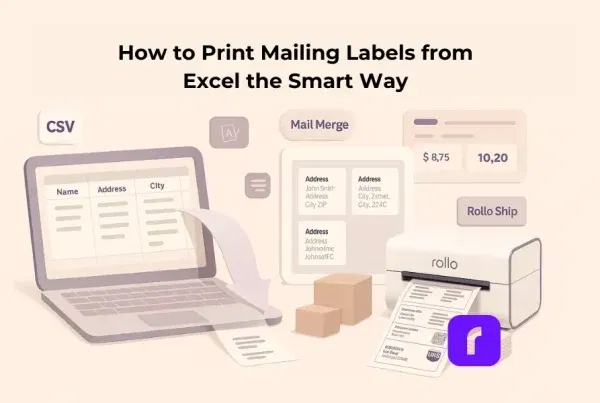TL;DR: The cheapest way to ship a box in 2025 depends on its weight and size. USPS Ground Advantage is typically cheapest for packages under 10 lbs, while discounted UPS Ground through platforms like Rollo Ship can save up to 90 % on heavier boxes. Always compare real-time rates before printing labels to minimize costs.
You’ve probably been there — chasing the cheapest shipping deal, only to end up with lost packages, late deliveries, or customer complaints that cost more than the savings ever did. It’s easy to believe that the cheapest way to ship a box always means cutting corners. But that’s changing. In 2025, small businesses can ship smarter—accessing deep USPS and UPS discounts through tools like Rollo Ship—without giving up the first-class service customers expect. This guide shows how to save money and keep your reputation intact.
Your Roadmap to Finding the Cheapest Way to Ship a Box
Why “cheap” shipping doesn’t have to mean low quality
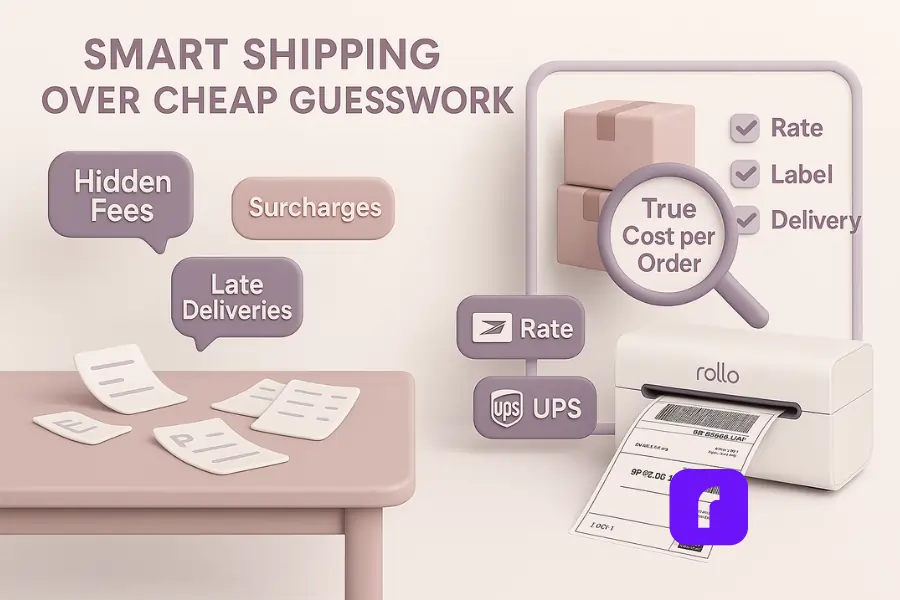
Cheap can be smart, not sloppy. When you compare carrier rates side-by-side and account for hidden fees, you can choose a cost-effective option that still delivers on time. Modern tools expose carrier surcharges and help you pick the best value for each box.
Most small businesses lose money to guesswork. They assume low price means slow shipping speed. Or they forget to factor fuel surcharges, residential surcharges, or address corrections. The fix is simple: the cheapest way to ship a box starts with the package, then the rate, then the label.
What this section covers: how to think in costs per order, how to see the “true” total cost, and how to set a default service that’s generally cheaper for your typical order mix.
What’s the cheapest way to ship a box?
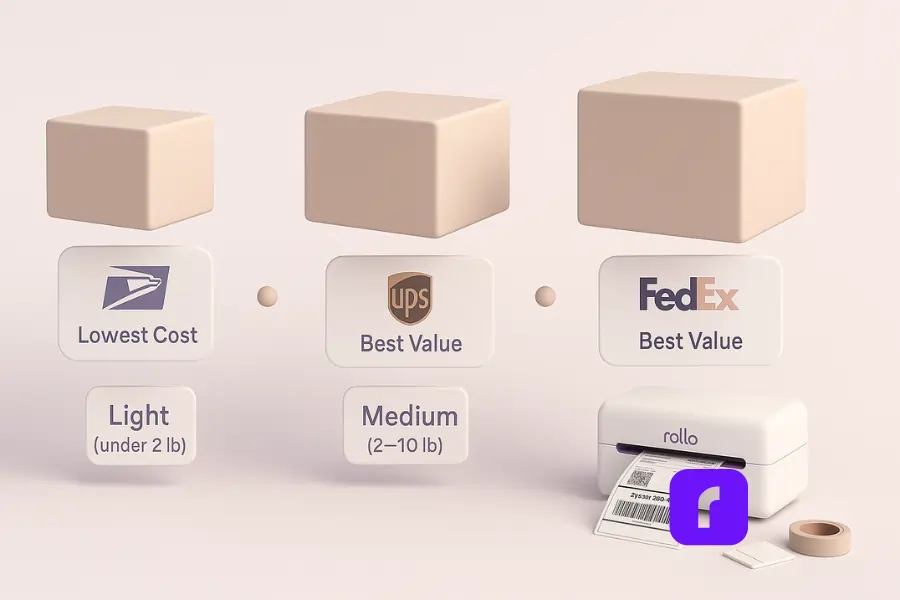
The cheapest way to ship a box depends on the size and weight of the box. For small packages under 16 oz, USPS First-Class Mail is usually the cheapest way to ship a box. Between 1 and 2 lb, USPS Ground Advantage often offers the lowest rates. Once your package passes 2 lb, UPS Ground or FedEx Ground typically provide better value—especially when using platforms with discounted shipping rates.
Cheapest way to ship light packages (under 2 lb)
If your parcel is under 16 oz, First-Class is tough to beat for domestic shipping. From 1–2 lb, USPS Ground Advantage usually wins, but always check zones and package dimensions. A smaller parcel box lowers actual weight and DIM fees.
Quick tips:
- 📦 Use your own box sized tight.
- 💨 Avoid “air.” DIM fees hit when package size is bloated.
- 🖨️ Print the shipping label online to avoid retail prices.
Cheapest way to ship medium boxes (2–10 lb)
Here it gets interesting. USPS Ground Advantage can still win on short zones. But UPS Ground Saver or standard UPS Ground may beat USPS once zones stretch. A rate-comparison tool shows the “flip points” fast.
Watch list:
- 📐 Cubic pricing for dense, small boxes.
- 📦 Flat rate packages vs zone-based pricing.
- ⏱️ Delivery time promises vs actual needs.
Cheapest way to ship large packages (10+ lb)
When dimension and weight climb, ground services from UPS or FedEx often win—especially with multiple couriers in one dashboard. If the item is heavy but compact, USPS flat rate boxes can still punch above their weight.
Pro move: Determine the cheapest way to ship a box by A/B split testing. Test three services for one SKU and document the winner by zone. Your team then follows a simple rule: “If X, choose Y.” Repeat savings, fewer decisions. learn the secret to getting the best shipping rates.
How do I calculate shipping costs accurately?
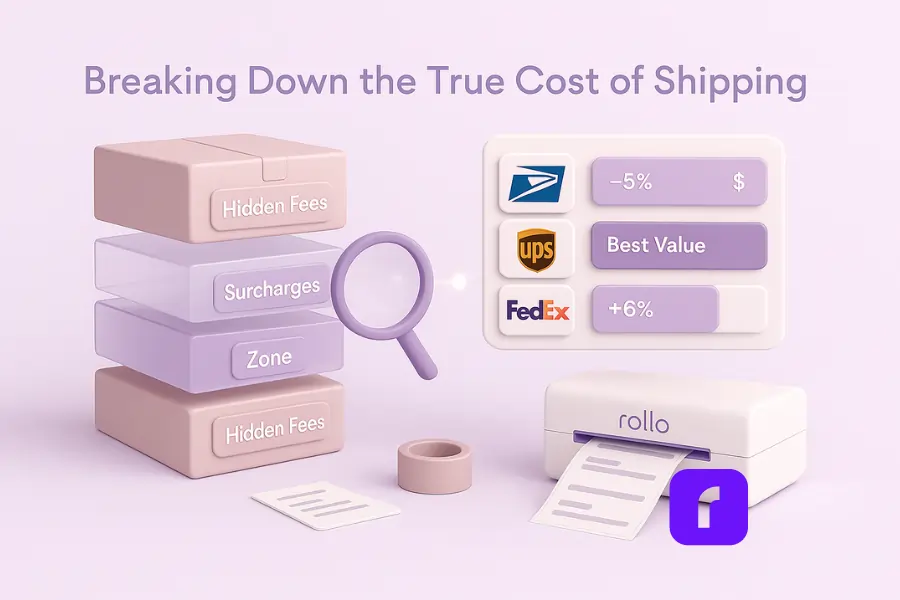
To calculate shipping costs, start with three inputs: package dimensions, actual weight, and shipping zones. Then add additional fees like fuel surcharges, residential surcharges, and address corrections to find the true total cost. If you want a deeper breakdown of how carrier rates stack up by weight and distance, check out our guide on the cheapest way to ship a package for practical comparisons and examples.
Here’s a quick checklist you can reuse:
- Measure length × width × height to the nearest 0.25″.
- Weigh the box after packing.
- Note the zone or destination country.
- Run rates in an online tool that shows cheapest shipping rates across carriers.
- Scan for hidden fees and extra fees (peak, residential, Saturday).
How cubic pricing and DIM rules change the game
“Light but bulky” can cost more than you think. DIM applies when volume triggers a higher billable weight than the scale. Smaller boxes and right-sized packing materials reduce surprises.
Avoiding hidden costs and extra fees
- 📬 Validate addresses to dodge correction fees.
- ⛽ Watch fuel or residential surcharges.
- 🌍 For international shipments, include import taxes and duties in your shipping cost estimate.
Which shipping carrier offers the best value?
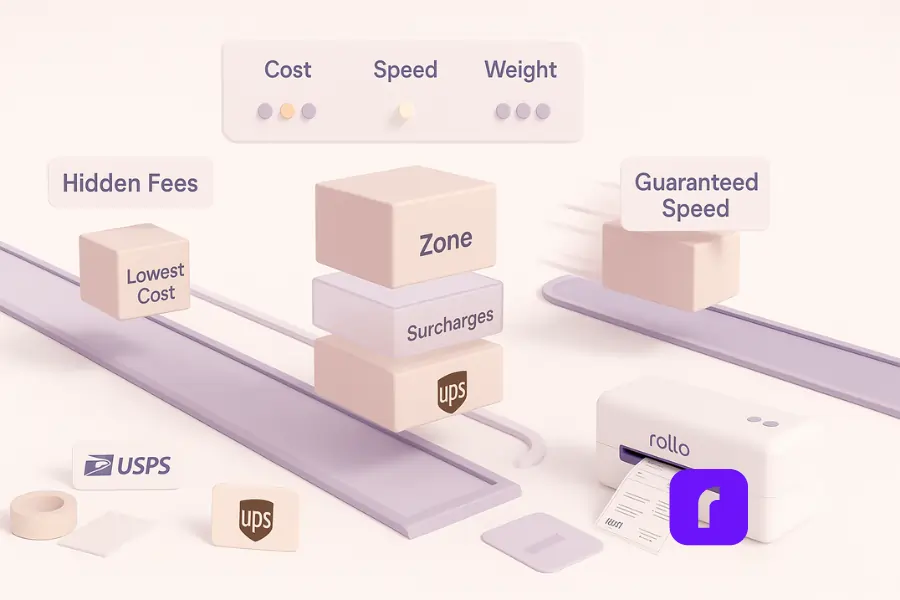
Each shipping service shines in different lanes. USPS usually wins for small boxes and flat rate shipping. UPS tends to win on heavy ground. FedEx often wins on speed with FedEx guarantee delivery. The “best value” is the one that meets your delivery time at the lowest total cost.
USPS — small packages and flat rate boxes
- 📦 USPS Ground Advantage: great for small packages and short zones.
- 🚀 Priority Mail and USPS Priority Mail Express: faster tiers when needed.
- 📫 USPS flat rate boxes: strong when dense weight fits the size.
UPS — reliable ground for heavier boxes
- 🏋️ Strong for 10+ lb or long zones.
- 💰 UPS Ground Saver: low-cost option when speed can flex a bit.
- 📡 Clear tracking number updates and predictable transit.
FedEx — fast delivery and guarantees
- ⏱️ “Need it there by X?” Choose FedEx for fast shipping with guarantees.
- 📦 Strong for specific lanes and large packages when you hit a sweet spot.
Bottom line: You’ll compare rates every time. Let the data pick the cheapest way to ship a box.
🚚 Ship Smarter, Not Slower — With Rollo Ship
Find the cheapest way to ship a box without guesswork. Rollo Ship instantly compares rates from USPS, UPS, and FedEx—helping you save money and deliver on time.
Pair it with your store or marketplace to:
- 💸 Unlock up to 90% off discounted shipping rates
- ⚡ Compare delivery speeds side-by-side before you ship
- 🧾 Print and track all your orders from one dashboard
Cheapest way to ship a box internationally without surprises
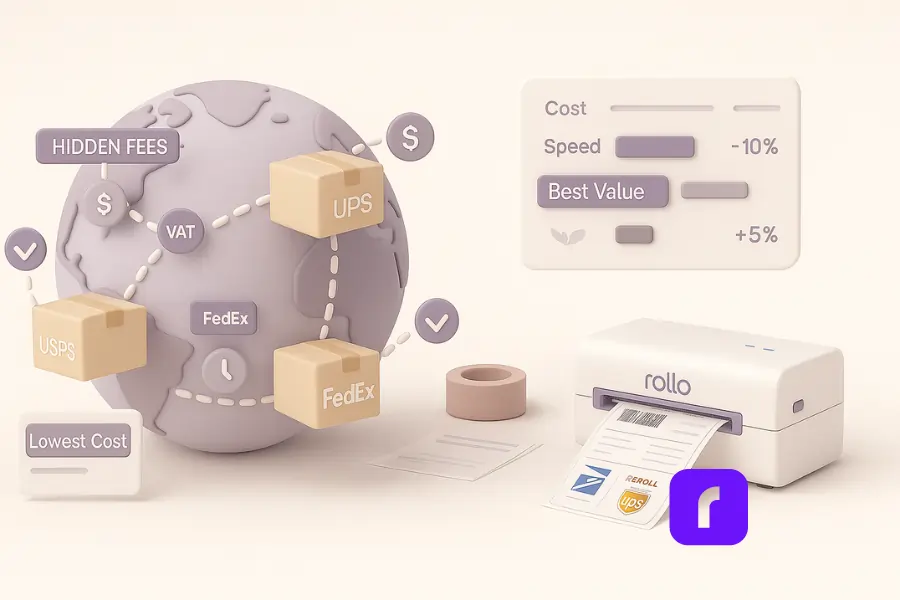
The cheapest way to ship a box internationally starts with choosing shipping services in your weight range. USPS is cost effective for small parcels. UPS and FedEx can be faster or cheaper for certain lanes. Always add international shipping costs like duties and import taxes to your estimate.
Understand duties, VAT, and import taxes
Two boxes with the same weight can land wildly different bills at customs. Use a calculator that shows landed cost. Your best value might change once taxes enter the chat.
Cheapest options for small international boxes
- 🌍 USPS Priority Mail International for value.
- ✈️ UPS Saver or DHL Economy for speed and smooth tracking.
- 🔄 Compare both — some lanes flip based on zone and season.
Tracking, insurance, and delivery speed abroad
Add shipping insurance for higher-value items. Show clear timelines in your storefront. Customers forgive a day slower if they get great comms.
How packaging and labeling cut shipping cost (and stress)
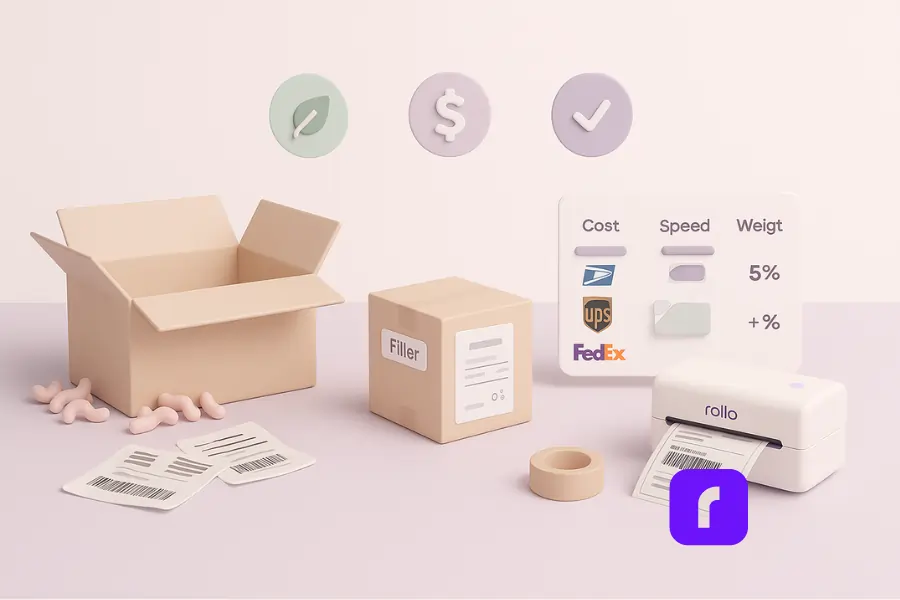
Right-sized packaging materials and thermal shipping labels can lower shipping costs and speed your day. Smaller boxes reduce DIM. Thermal printing avoids ink surprises and label smears. Your team spends more time selling and less time reprinting.
If you’re running a small e-commerce business, you can also explore our full guide on cheap shipping for small business — it covers practical ways to package smarter, print faster, and save more per shipment.
Right-size every parcel
Smaller package size = lower shipping cost. Fill voids with light, protective material. Avoid big boxes “just in case.”
Thermal vs. inkjet labels
Thermal labels print crisp, fast, and clean. No ink. No smudges. It’s ideal for busy teams who need a dependable shipping label every time.
Sustainability can be cheaper
FSC-certified, BPA-free labels and smart boxes reduce waste and returns. Fewer damages. Fewer replacements. Lower delivery costs over time.
Common hidden fees that make “cheap” expensive
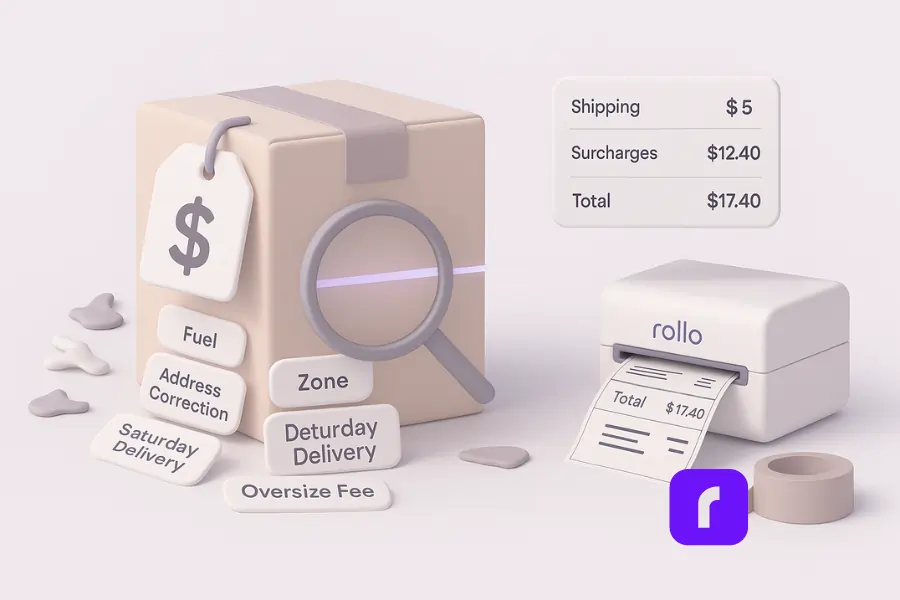
That low sticker price can balloon with carrier surcharges and hidden fees. Address corrections, peak fees, and fuel surcharges add an extra cost that erodes margin. Seeing them upfront helps you choose the true cheapest way to ship a box for each order.
The frequent offenders
- 📬 Address correction fees.
- ⛽ Fuel or residential surcharges.
- 📦 Oversize and non-machinable fees.
- 🗓️ Saturday and signature fees.
How to avoid them
- 🧭 Use address validation.
- 📏 Pack to standard sizes where possible.
- 🚚 Pick services with fewer add-ons for your lanes.
What’s the cheapest way to ship a box when prices go up?
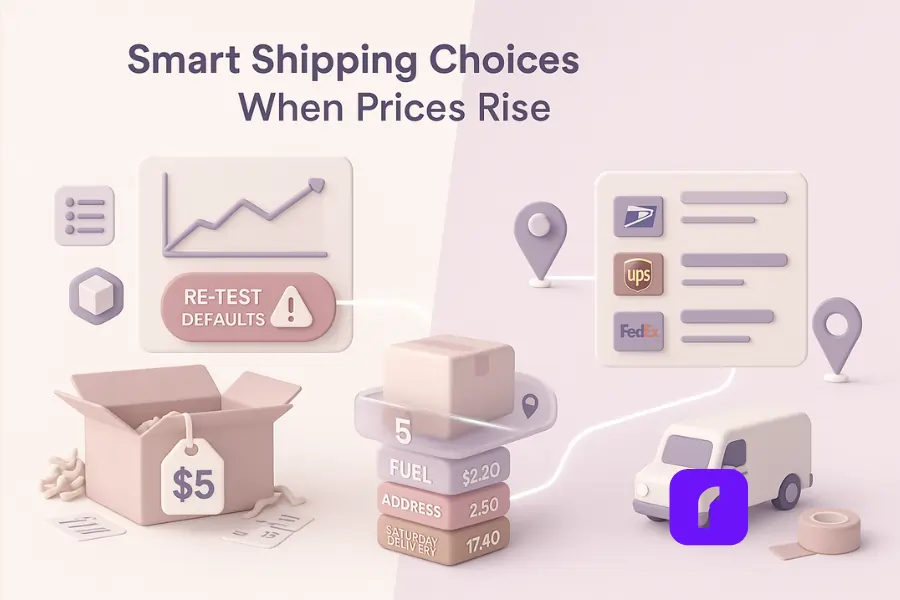
When retail prices rise, the winner changes by weight and zone. The smart move is to re-test your defaults. For many sellers, discounted shipping rates with ground services now beat old habits—especially if you ship mid-weight boxes to distant zones.
What to update this quarter
- 📊 Re-benchmark your top five SKUs.
- 🗺️ Re-map shipping zones to service tiers.
- ⚡ Refresh your storefront promises for fast delivery vs best value.
Offer local delivery when it beats parcel shipping
Sometimes the cheapest way to ship a box is not shipping it at all. If you sell to nearby customers, offering local delivery can undercut parcel rates and shave a day off transit. It’s simple math: fewer miles, fewer fees, faster smiles.
When local wins
- 🏋️ Heavy, low-margin items.
- 🫙 Fragile goods that hate trucks.
- 🚗 Sales spikes where a short drive saves the day.
How to pick the cheapest way without hurting service
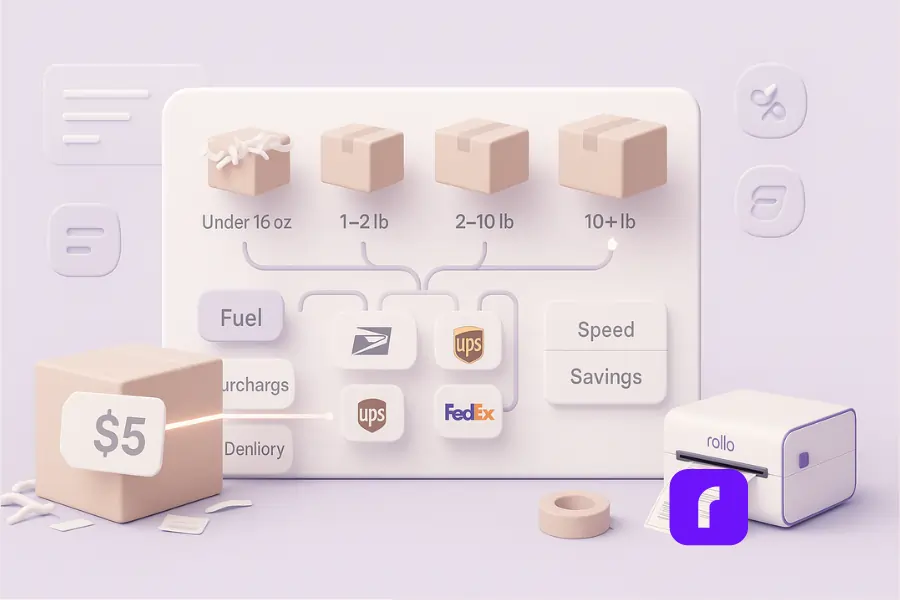
Set rules, not guesses. Use data to assign a default for each common box size and weight, then allow an override when zones or deadlines change. You’ll keep delivery speed reliable and your shipping cost low.
A simple ruleset you can copy
- ✉️ Under 16 oz: USPS First-Class; if deadline tight, upgrade.
- 📦 1–2 lb: USPS Ground Advantage; check zone for flips.
- ⚖️ 2–10 lb: Compare USPS vs UPS Ground Saver; pick the cheaper.
- 🏋️♂️ 10+ lb or bulky: UPS/FedEx Ground; test flat rate if dense.
Final Words
The cheapest way to ship a box shouldn’t wreck your service. With tight packaging, a clear way to ship by weight and zone, and a tool that surfaces cheapest shipping rates and extra fees in one place, you’ll lower shipping costs and keep customers happy.
Test once. Document. Repeat. That’s how you build a shipping playbook that holds up at scale.
🖨️ Print First-Class Labels for Every Shipment
Using the cheapest way to ship a box doesn’t mean cutting corners. The Rollo Wireless Label Printer delivers sharp, professional labels—no ink, no cables, no wasted rolls.
Use it with Rollo Ship to:
- 🕒 Cut label prep time by up to 75%
- ✨ Keep your packaging looking clean and professional
- 🌱 Print eco-friendly, ink-free thermal labels that last
Follow Rollo on:
Frequently Asked Questions About The Cheapest Way to Ship a Box
📌 Q: What’s the cheapest way to ship a box under 2 lb?
💭 A: USPS First-Class (under 16 oz) or USPS Ground Advantage is usually the cheapest shipping service. Always run a quick check by zone, since short hops can shift the winner. Print the package online to avoid counter retail prices.
📌 Q: How do I calculate shipping costs accurately?
💭 A: Measure package dimensions, weigh it, and note the zone. Use a tool that shows multiple couriers side-by-side, including additional fees like fuel surcharges. That’s your true total cost.
📌 Q: Is flat rate always cheaper?
💭 A: No. Flat rate boxes shine for heavy, compact items. If your box is light or large, zone-based pricing or UPS Ground may be cheaper. Test both to find the best value.
📌 Q: How can I avoid hidden fees?
💭 A: Validate addresses. Pack to standard sizes. Watch for carrier surcharges like residential, fuel, and Saturday. A good dashboard shows hidden costs before you buy.
📌 Q: What about international shipping costs?
💭 A: Add duties, import taxes, and brokerage fees to your math. USPS can be cheapest for small items; UPS or DHL may win on lanes where speed and tracking matter most.
📌 Q: Should I offer local delivery?
💭 A: If you’ve got nearby customers and heavy items, yes. Local delivery can beat parcel on price and delivery time while giving you tight control over service.
📌 Q: When should I add shipping insurance?
💭 A: If a loss would sting, insure it. International or higher-value items deserve coverage. The small extra cost prevents big headaches.
